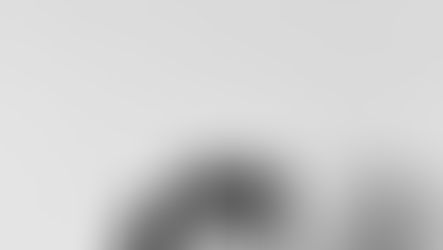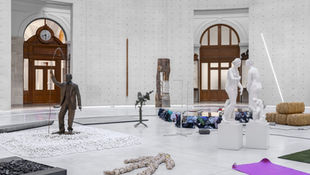
Pierre Soulages: The Alchemy of Black
Pierre Soulages, known as the "painter of black" or le peintre du noir, is among the most radical and philosophical of abstract artists. Not merely for his technique or medium, but for the metaphysical questions his oeuvre evokes. With his invention of Outrenoir, literally “beyond black” - Soulages transcended the traditional dualities of light and darkness, presence and absence, visibility and invisibility. In his canvases, black is not an end but a passage, not the absorption of light but the generation of it. To look at a Soulages painting is not simply to view an image, but to encounter a philosophical proposition: What is the nature of perception, and can absence itself become a form of presence?

In 1979, Soulages made a pivotal discovery. Dissatisfied with his own work, he began applying thick layers of black paint on canvas using unconventional tools - knives, brushes, spatulas - and then manipulating the surface to catch and reflect light. What emerged was not simply a black painting, but a painting of light, using black as the medium. This gave birth to his concept of Outrenoir, which translates imperfectly into English. It is not “beyond black” as in more black, but rather black as a portal—black as a threshold into another kind of visual and emotional reality. Philosophically, this is an act of inversion. In Western metaphysics, black is often equated with nothingness, chaos, or death; light, with being, truth, and divinity. Soulages collapses this binary. His black paintings reflect light; they shimmer, shift, and pulse as the viewer moves, creating a dynamic, living surface. Thus, black becomes generative. In Outrenoir, we find a visual metaphor for what Heidegger called aletheia - the disclosure of truth through the unveiling of being.
To walk into a room of Soulages’s paintings is to be surrounded by entities that refuse to reveal themselves all at once. They must be circled, approached, inhabited. The light is not painted - it is revealed, sculpted by the texture of black. The viewer does not observe; they participate. The art exists in the relational space between the object and the observer. Soulages’s aesthetic sensibility aligns closely with the phenomenology of Maurice Merleau-Ponty, particularly in the idea that perception is not passive reception but embodied engagement. In his Phenomenology of Perception, Merleau-Ponty argues that vision is not merely a matter of optics - it is rooted in the body, in motion, in temporality. The world is not seen in an instant but revealed through time and space.
Soulages's paintings demand just this kind of temporal, mobile engagement. A single canvas may present multiple visual experiences depending on one’s position, the time of day, or the angle of lighting. They change not in substance, but in experience. This relational temporality creates a phenomenological loop: the painting reflects the viewer’s presence, not metaphorically, but literally, in the mirrored textures of its black surfaces. This dynamic has theological and existential implications. If the world is not a static object but a co-created field of appearance, then the work of art becomes a kind of sacred site - a place where being unfolds through presence and attention. The canvas is not a window but a mirror; not an object but an event.
The artist was notoriously uninterested in representation. He once remarked, “I do not depict. I do. I act.” In this, he echoes the existential artists and thinkers of the 20th century - from Sartre to Rothko - who saw art not as depiction, but as presence, as action in the world. The canvas is not a depiction of a world; it is a world, and the artist is its midwife. In choosing to restrict his palette, Soulages performs a kind of aesthetic asceticism, reminiscent of Zen calligraphy or Islamic geometric abstraction. By limiting the content, he amplifies the form. The focus on black becomes a purification of seeing, stripping away symbolic or figurative distractions to engage with the pure event of light and matter.

This reduction is not nihilistic, but ontological. In his later years, Soulages spoke of black as "the most intense, the most violent, the most absent colour." In black, all colours are latent; in it, the entire visible spectrum is suspended. Thus, black is not void - it is potential. Here we may recall the ancient Greek concept of chaos, not disorder, but the raw, fertile ground of being. Soulages paints chaos not as horror, but as horizon. His black is a field of potentiality, a space where light is born from darkness.
Though Soulages was not religious in the traditional sense, his work has often been described as spiritual. In 1994, he was commissioned to design the stained-glass windows of the Abbey Church of Sainte-Foy in Conques, a Romanesque church in southern France. His minimalist, abstract approach shocked many, yet the result was profoundly contemplative. The windows do not depict saints or stories. They filter light - softly, silently - allowing space for interiority and reflection. In this sacred context, Soulages’s art reaches its full metaphysical dimension. Like the iconostasis in Eastern Orthodox tradition or the blank meditation screens of Zen, his work becomes a vehicle for the unrepresentable. The black surfaces reflect not just physical light, but inner states of awareness. They invite not interpretation, but silence. In a world of endless images and noise, Soulages offers us darkness, not as negation, but as sanctuary. The Outrenoir paintings are spaces of withdrawal, where the self is both confronted and dissolved. They do not speak. They resonate.
Pierre Soulages’s legacy is not merely aesthetic but ontological. He compels us to reimagine the nature of light, the role of colour, and the essence of art itself. Through his disciplined devotion to black, he reveals the paradox that it is often in darkness that light is most profoundly felt. His paintings are not representations but invitations - spaces in which perception itself becomes the subject. In a time dominated by the visible, Soulages reminds us of the power of the unseen. His work stands as a testament to the depth of human perception and the mystery at the heart of being. Through black, he teaches us to see not less, but more—to look, to move, to engage.





